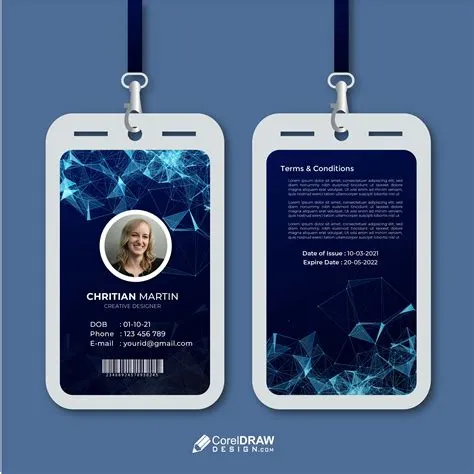Hey there, business owners and brand enthusiasts! Ever stop to think about your company ID cards? They’re more than just a piece of plastic; they’re a walking, talking advertisement for your brand, a symbol of belonging for your team, and a crucial tool for security. And guess what? ID card design is exploding with innovation! We’re moving beyond the boring, generic cards of the past, embracing fresh designs and cutting-edge technology. So, let’s dive into the exciting world of innovative business ID card design trends, shall we?
The Rise of Interactive Technology
Remember those clunky, static ID cards? They’re practically relics now! Today’s ID cards are smarter, more interactive, and packed with features that boost efficiency and security. Think of it like this: your ID card is transforming from a simple name tag into a mini, personalized tech device. One key advancement is the integration of technology-integrated ID cards, allowing for contactless access control, data storage, and even personalized messaging.
Imagine this: employees can simply tap their ID card to access secure areas, clock in and out, and even make purchases at company cafeterias. No more fumbling with keys or signing in manually! This not only streamlines processes but also enhances security. How cool is that? Moreover, the potential for customization is endless. Want to incorporate QR codes linking to employee profiles? Done. Need to embed NFC chips for contactless payments? Absolutely! This level of customization and personalization in ID card design is revolutionizing how businesses manage access and information.
Eco-Friendly Materials and Sustainable Practices
We’re increasingly aware of our environmental impact, and that extends to even the smallest details, like ID cards. Thankfully, eco-consciousness is becoming a significant trend in ID card design. Companies are now choosing eco-friendly ID card materials, opting for recycled plastics, biodegradable options, and sustainably sourced paper. It’s a fantastic way to demonstrate your commitment to environmental responsibility while still creating stylish and functional ID cards.
But it’s not just about the materials; the printing process is also changing. Eco-friendly printing techniques, such as soy-based inks and water-based coatings, minimize the environmental footprint. This move towards sustainability isn’t just a trend; it’s a reflection of a growing societal demand for ethical and responsible business practices. Think about it – wouldn’t you rather support a company that cares about the planet?
Industry-Specific Designs: Tailored to Your Business
One size doesn’t fit all, and that’s especially true for business ID cards. The days of generic, impersonal ID cards are numbered. We’re seeing a surge in industry-specific ID card designs that reflect the unique branding and functionality of different sectors. A healthcare provider’s ID card will look vastly different from that of a tech startup, for example.
For instance, a construction company might prioritize durability and water resistance, while a high-end boutique might focus on elegant aesthetics. These design trends in industry-specific ID cards are not just about looks; they also reflect the practical needs of the industry. Functional aspects of industry-specific ID cards are key to success. The design should reflect your company’s values, and its functionality should streamline your operations.
Modern Aesthetics: Elevating Your Brand
Let’s face it: a visually appealing ID card makes a statement. Modern design trends prioritize clean lines, minimalist aesthetics, and bold typography. Think vibrant color palettes reflecting your brand identity, sophisticated fonts that exude professionalism, and imagery that tells your company’s story. Modern ID card design ideas are all about making a lasting impression.
Your ID card is a miniature billboard for your company. It’s a small detail that can significantly contribute to your brand image. Consider the power of corporate branding with ID cards. A well-designed card can instantly communicate professionalism, creativity, and innovation, subtly influencing perceptions of your company. Don’t underestimate the power of visual communication.
Security and Access Control: Protecting Your Assets
Security remains paramount, and innovative ID card designs are addressing this need with advanced security features. Holographic elements, embedded microchips, and watermarks are just a few examples of the technologies enhancing the security of ID cards. This is especially important for businesses dealing with sensitive information or requiring strict access control.
Think about it: how can you protect your premises and data if your ID cards are easily duplicated or compromised? Integrating advanced security features into your ID card design is an investment in the protection of your assets. Security and access control are no longer an afterthought; they’re a core component of modern ID card design. This heightened focus on security is a reflection of growing awareness of the need to protect data and physical assets.
The Future of ID Cards: A Glimpse Ahead
The evolution of ID card design is far from over. We can expect to see even more innovative features emerge, blurring the lines between physical and digital identities. Digital and virtual ID cards are gaining traction, offering seamless integration with mobile devices and online systems. The future holds exciting possibilities for ID card design, promising increased efficiency, enhanced security, and a more sustainable approach.
Imagine a world where your ID card is also your access key, your payment method, and your digital identity – all in one sleek and secure package. This integrated approach streamlines operations, enhancing both security and efficiency. The possibilities are truly limitless. This is the future of business ID cards, and it’s more exciting than ever before.
Ultimately, choosing the right ID card design is a strategic decision. It’s about aligning your card design with your brand identity, your industry requirements, and your commitment to sustainability. By considering these trends and integrating innovative features, you can elevate your brand image, improve operational efficiency, and enhance the overall security of your business. It’s all about finding the perfect balance between functionality, aesthetics, and security.
Conclusion
The world of business ID cards is undergoing a thrilling transformation, driven by technological advancements and a heightened focus on sustainability. By embracing innovative designs, eco-friendly materials, and advanced security features, businesses can create ID cards that are not only functional and secure but also reflect their brand identity and commitment to environmental responsibility. So, step up your ID card game and reap the benefits of this exciting evolution!
Frequently Asked Questions
Q1: How much does it cost to design and print innovative ID cards?
The cost varies significantly based on factors such as materials, printing techniques, quantity, and the complexity of the design. It’s best to obtain quotes from several ID card providers to compare pricing and features.
Q2: What security features are most effective for business ID cards?
Effective security features include holographic elements, embedded microchips, UV printing, watermarks, and laser engraving. The optimal combination will depend on your specific security needs and budget.
Q3: How can I ensure my ID card design reflects my company’s brand?
Work closely with a designer to incorporate your company’s logo, color palette, fonts, and imagery into the design. Maintain consistency with your overall branding guidelines to create a cohesive and professional image.
Q4: Are eco-friendly ID cards as durable as traditional plastic cards?
Many eco-friendly materials offer comparable durability to traditional plastic. However, the specific durability will depend on the chosen material and printing techniques. Discuss your requirements with your supplier to find the best balance between sustainability and durability.
Q5: What are the benefits of integrating interactive technology into ID cards?
Integrating interactive technology offers several benefits, including streamlined access control, contactless payments, improved data management, and enhanced security. It can also contribute to a more efficient and modern workplace.

